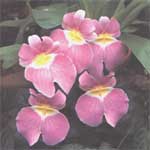Orchids (orchids) / orchidaceae
General description: Orchids are luxurious ornamental and flowering plants. They are appreciated for their beauty and the duration of flowering. In addition, they usually bloom in winter, at what time no other flowers. Relatively recently, some species of orchids began to grow in indoor conditions. Orchid - quite demanding plant, but with competent treatment can successfully grow and bloom. It is proud to provide her with an unmistakable period of inactivity.
All species must have a pseudobulb - a thickened stem, from which leaves and peduncles leave. It can be cylindrical, ovoid or spherical. Later, as if the plant is blossoming, pseudobulb can be preserved without leaves for several years. Leaves are long, leathery. Orchid flowers are built according to one scheme, but they are extremely diverse in shape, size and coloration of individual elements. The flower consists of the upper and a pair of lateral sepals, a pair of side lobes and a lower petal called the lip. The lip necessarily differs from the other petals both in shape and color. Flowers can be single or in inflorescences - spicate, racemose or paniculate. A fruit is a box with dusty seeds.
Recommendations for caring for a family of orchids (orchids):
Illumination : In summer I need a bright but diffused light. In winter, shading is not necessary, requires additional artificial lighting.
Irrigation regime : The soil for most orchids should be all wet, watering should be uniform. Orchids do not like in any way not overflow, nor drying up of the earth. Katlei and miltonia are watered to the point of desiccation of the earth.
To water with warm soft water.
It is recommended to water the method by immersing the pot in a tray with water up to a full saturation.
Humidity : Love the high humidity, but the flowers of orchids do not like spraying. It is better to spray the atmosphere around the plant and arrange containers with water.
The humidity of the air is similarly supported by placing pots on a pallet with pebbles or claydite, which is continuously moistened. Do not endure drafts and sudden temperature changes.
Temperature mode: Depends on the type of orchids. Dendrobiums, pafiophyllums, tselinii prefer coolness, the lilies require moderate temperature, phalaenopsis, vandas, some dendrobiums and cattleya need warmth. But the total demand: in summer the daily temperature is around 20 0 C, in winter near 170 C, the night temperature is 2-3 degrees lower.
Soil : Proper benign drainage is required. It is allowed to add charcoal or expanded clay.
Recommended soil mixture: 1 share of peat moss, 1 share of chopped pine bark. A mishmash for orchids will do.
During the growth period, you need regular fertilizing for orchids or usual in half of the portion indicated on the package.
Breeding : Crushing during transplantation. In each element there should be no less than three sprouts. The transplanted plant is attached to the support.
Transplantation : Transplanted in the spring, at what time the pot is made tight (the roots begin to germinate through the drainage holes).
Pests : affected by scutes (brown plaques appear on leaves and stems, leaving sticky excretions), aphids, thrips (grayish dots appear on the leaves).
In these cases, the plant must be sprayed with solutions up to a full cure
Insecticides (actinic, decis, phytoverm, etc.)

Orchids (orchids) - orchidaceae


Comments
When commenting on, remember that the content and tone of your message can hurt the feelings of real people, show respect and tolerance to your interlocutors even if you do not share their opinion, your behavior in the conditions of freedom of expression and anonymity provided by the Internet, changes Not only virtual, but also the real world. All comments are hidden from the index, spam is controlled.